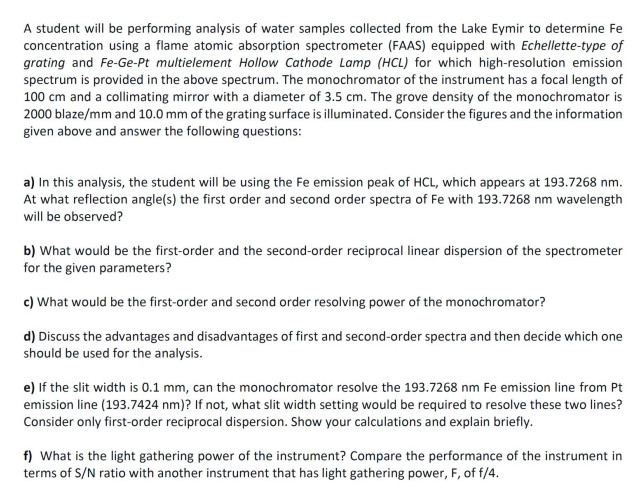A student will be performing analysis of water samples collected from the Lake Eymir to determine Fe concentration using a flame atomic absorption spectrometer (FAAS) equipped with Echellette-type of grating and Fe-Ge-Pt multielement Hollow Cathode Lamp (HCL) for which high-resolution emission spectrum is provided in the above spectrum. The monochromator of the instrument has a focal length of 100 cm and a collimating mirror with a diameter of 3.5 cm. The grove density of the monochromator is 2000 blaze/mm and 10.0 mm of the grating surface is illuminated. Consider the figures and the information given above and answer the following questions:
A student will be performing analysis of water samples collected from the Lake Eymir to determine Fe concentration using a flame atomic absorption spectrometer (FAAS) equipped with Echellette-type of grating and Fe-Ge-Pt multielement Hollow Cathode Lamp (HCL) for which high-resolution emission spectrum is provided in the above spectrum. The monochromator of the instrument has a focal length of 100 cm and a collimating mirror with a diameter of 3.5 cm. The grove density of the monochromator is 2000 blaze/mm and 10.0 mm of the grating surface is illuminated. Consider the figures and the information given above and answer the following questions:
Chapter4: Least-squares And Calibration Methods
Section: Chapter Questions
Problem 8P
Related questions
Question
Incident beam angle to the grating: 55 degrees

Transcribed Image Text:A student will be performing analysis of water samples collected from the Lake Eymir to determine Fe
concentration using a flame atomic absorption spectrometer (FAAS) equipped with Echellette-type of
grating and Fe-Ge-Pt multielement Hollow Cathode Lamp (HCL) for which high-resolution emission
spectrum is provided in the above spectrum. The monochromator of the instrument has a focal length of
100 cm and a collimating mirror with a diameter of 3.5 cm. The grove density of the monochromator is
2000 blaze/mm and 10.0 mm of the grating surface is illuminated. Consider the figures and the information
given above and answer the following questions:
a) In this analysis, the student will be using the Fe emission peak of HCL, which appears at 193.7268 nm.
At what reflection angle(s) the first order and second order spectra of Fe with 193.7268 nm wavelength
will be observed?
b) What would be the first-order and the second-order reciprocal linear dispersion of the spectrometer
for the given parameters?
c) What would be the first-order and second order resolving power of the monochromator?
d) Discuss the advantages and disadvantages of first and second-order spectra and then decide which one
should be used for the analysis.
e) If the slit width is 0.1 mm, can the monochromator resolve the 193.7268 nm Fe emission line from Pt
emission line (193.7424 nm)? If not, what slit width setting would be required to resolve these two lines?
Consider only first-order reciprocal dispersion. Show your calculations and explain briefly.
f) What is the light gathering power of the instrument? Compare the performance of the instrument in
terms of S/N ratio with another instrument that has light gathering power, F, of f/4.
Expert Solution
This question has been solved!
Explore an expertly crafted, step-by-step solution for a thorough understanding of key concepts.
Step by step
Solved in 2 steps with 1 images

Knowledge Booster
Learn more about
Need a deep-dive on the concept behind this application? Look no further. Learn more about this topic, chemistry and related others by exploring similar questions and additional content below.Recommended textbooks for you



Principles of Instrumental Analysis
Chemistry
ISBN:
9781305577213
Author:
Douglas A. Skoog, F. James Holler, Stanley R. Crouch
Publisher:
Cengage Learning



Principles of Instrumental Analysis
Chemistry
ISBN:
9781305577213
Author:
Douglas A. Skoog, F. James Holler, Stanley R. Crouch
Publisher:
Cengage Learning